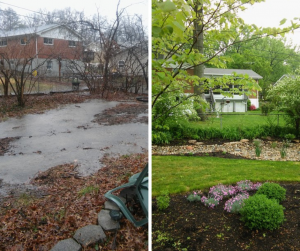Rain Gardens & Rainscaping : It’s Smarter Landscaping!
Modern homeowners are embracing smarter techniques when it comes to landscaping, which we love!
Smarter landscaping usually goes hand-in-hand with sustainability and the best long-term plan for your yard. One of the best ways to put your yard to work for you is by incorporating rain gardens or rainscaping elements into your outdoor living spaces.
Anyone worried about a damp basement, overworked sump pump, or muddy paw prints all over the house could benefit from a rain garden or rainscaping design.
Rain Gardens & Rainscaping
Rainscaping is a system to manage stormwater using a combination of catch basins, plantings, water features or permeable pavers. The system absorbs more water, leaving your yard healthier every time it rains. When designed correctly, you end up with a beautiful flower bed that also serves as a reservoir for your yard and roof runoff.
A rain garden is essentially a garden bed planted with special deep-rooted, water-loving plants like Sedge, Foxglove, Iris, or Coneflowers. Native plants are always recommended for a rain garden because they can survive when the soil is wet from heavy rains and also when soil is dry because they have adapted to St. Louis’ climate and soil conditions. These plants also attract beautiful dragonflies, butterflies & bees!
Another often overlooked benefit: Rain gardens minimize mosquitoes because the water is typically absorbed within 48 hours, which isn’t long enough for mosquitoes to breed. Plus, those newly attracted butterflies, birds & wildlife love to eat annoying mosquitoes.
Rainscaping is a great, eco-friendly solution to drainage issues, ponding, flooding, or lawn areas that require excessive maintenance. Oftentimes the results can be dramatic, expanding the usable outdoor space because the yard is healthier, with better drainage that turns that extra water into nourishment for gorgeous native plants.
Check out this backyard transformation!
 Rain Gardens don’t have to take up tons of room in your yard. Oftentimes we are replacing overgrown invasive Honeysuckle areas or uneven lawn space that isn’t being used. With smart planning and proper placement, you’ll end up with an ultra low maintenance new garden space that keeps your yard in better shape, year-round.
Rain Gardens don’t have to take up tons of room in your yard. Oftentimes we are replacing overgrown invasive Honeysuckle areas or uneven lawn space that isn’t being used. With smart planning and proper placement, you’ll end up with an ultra low maintenance new garden space that keeps your yard in better shape, year-round.
Next time your yard becomes a muddy mess, take photos! Document the excessive water and drainage issues you’re experiencing. Note how long water is left standing, before absorbing fully into the ground. If your yard stays soggy and wet for days on end, a rain garden may be the answer! This information can be invaluable when designing a rain garden (think about how unpredicable our St. Louis weather is), to select the best plants, materials, size, and other important elements that go into an overall cohesive rainscape.
Want to learn more? Watch our rainscaping video here!
